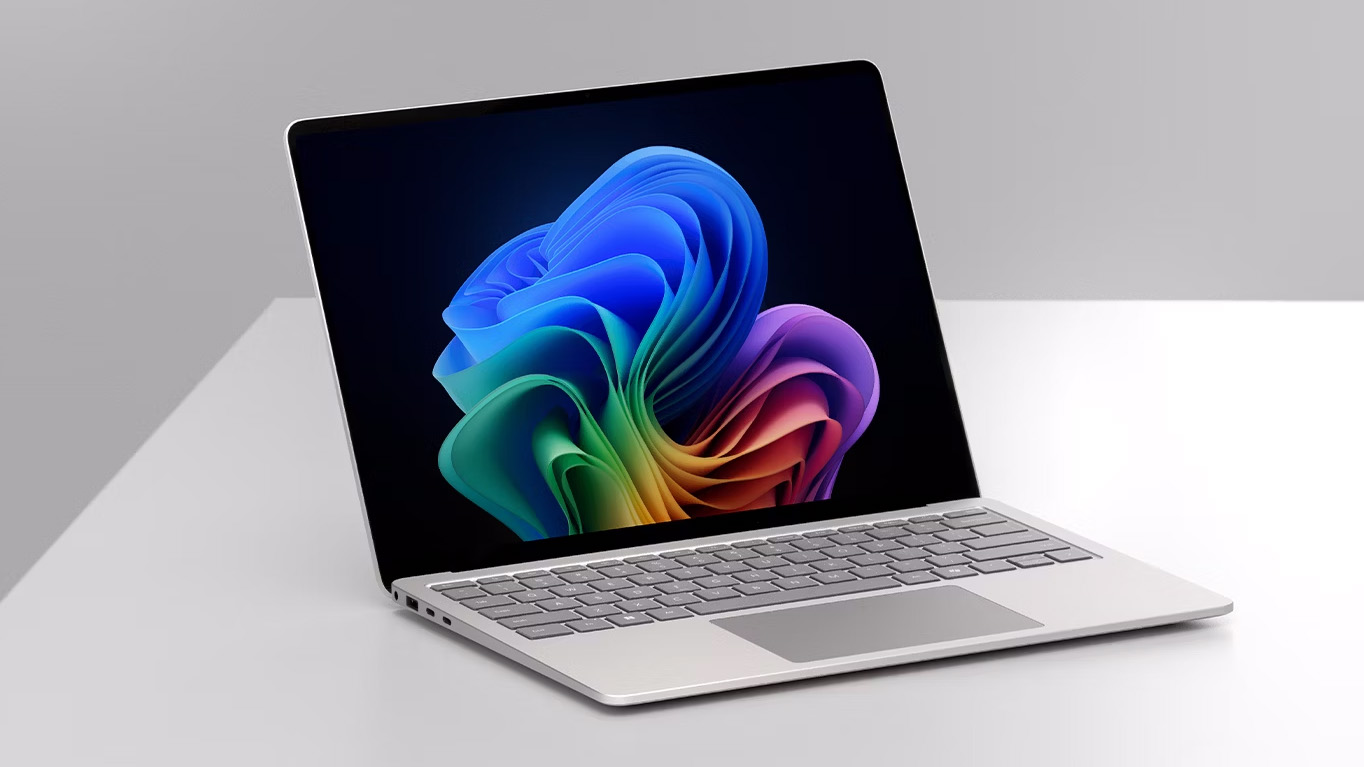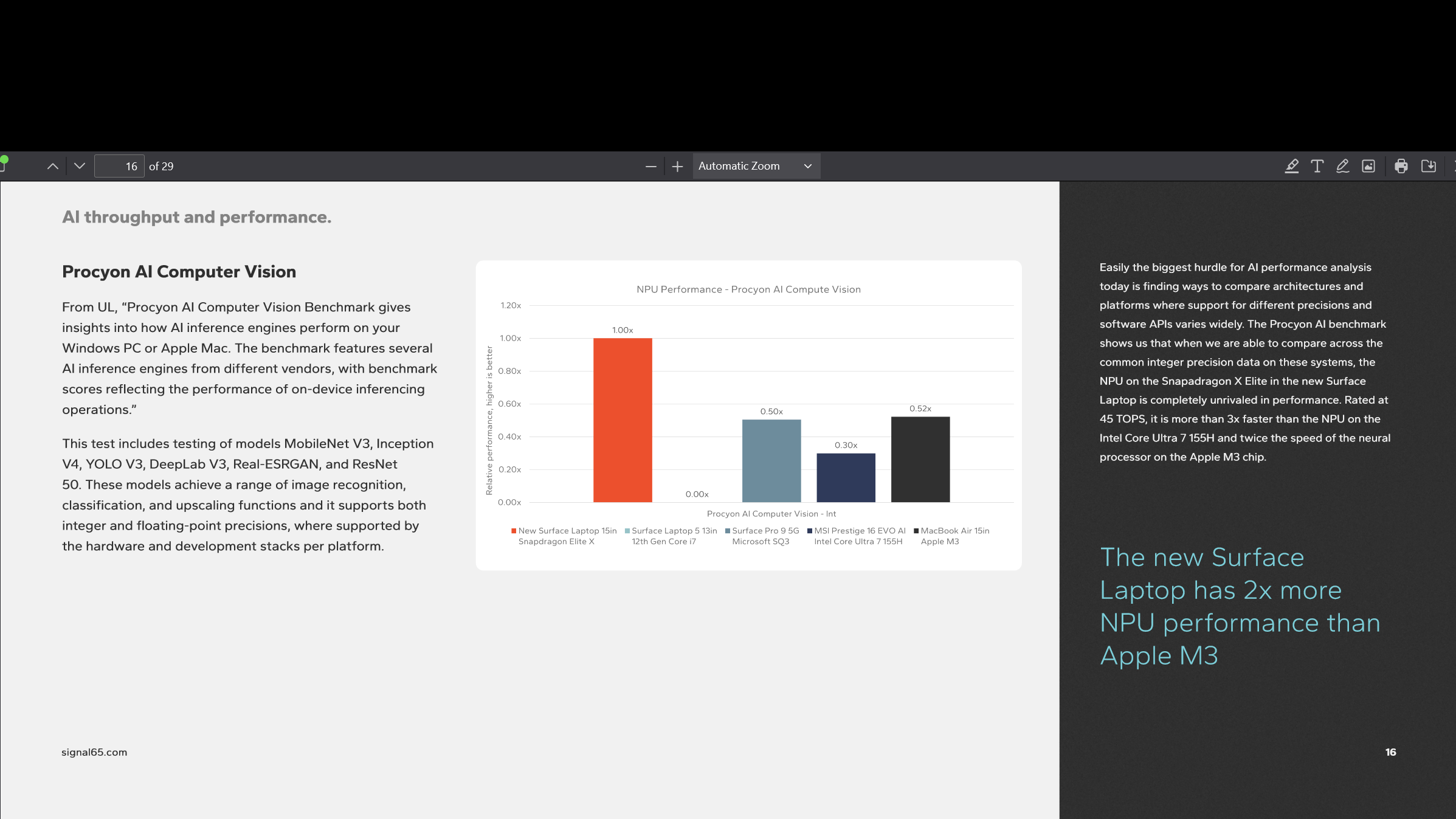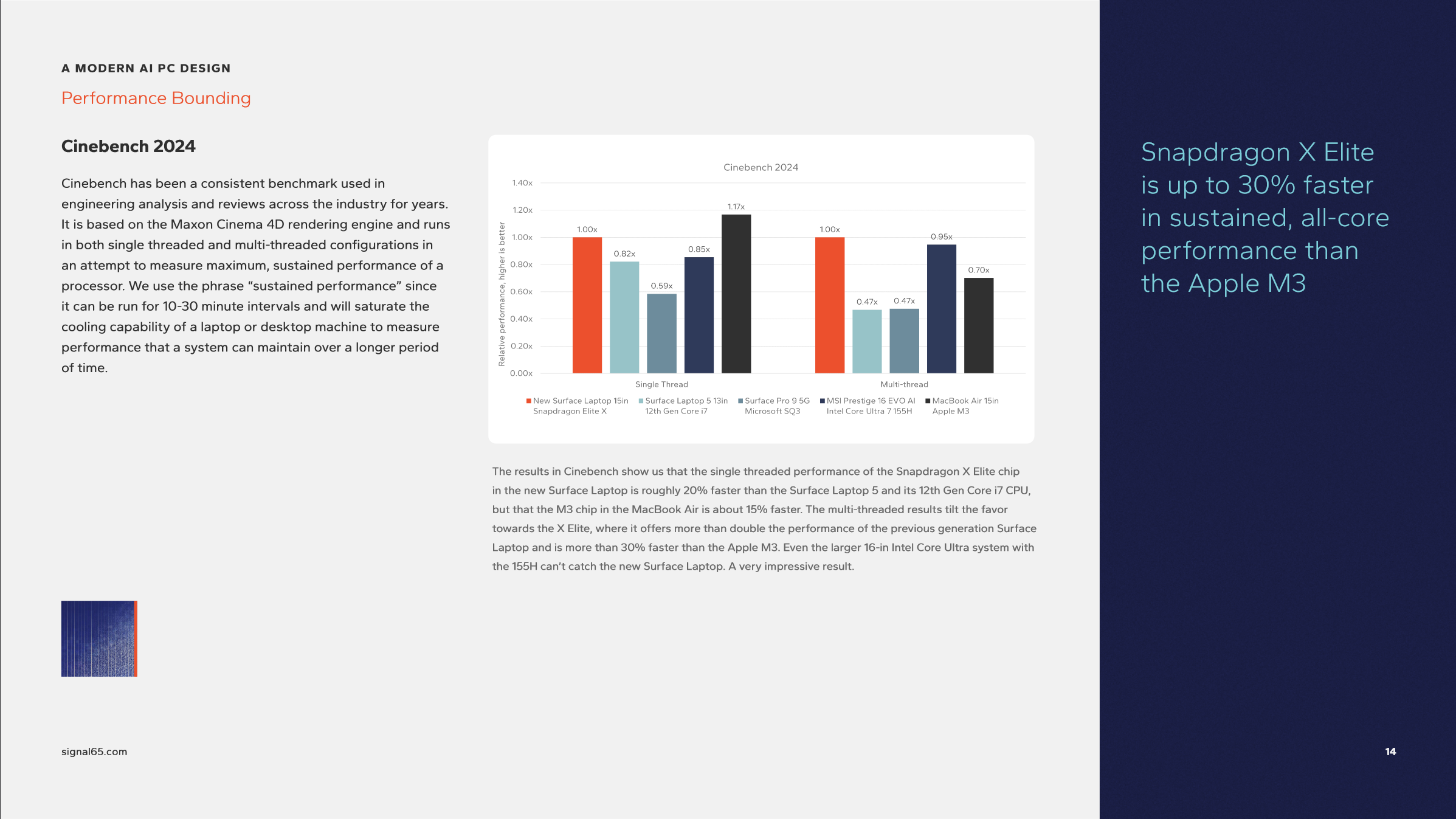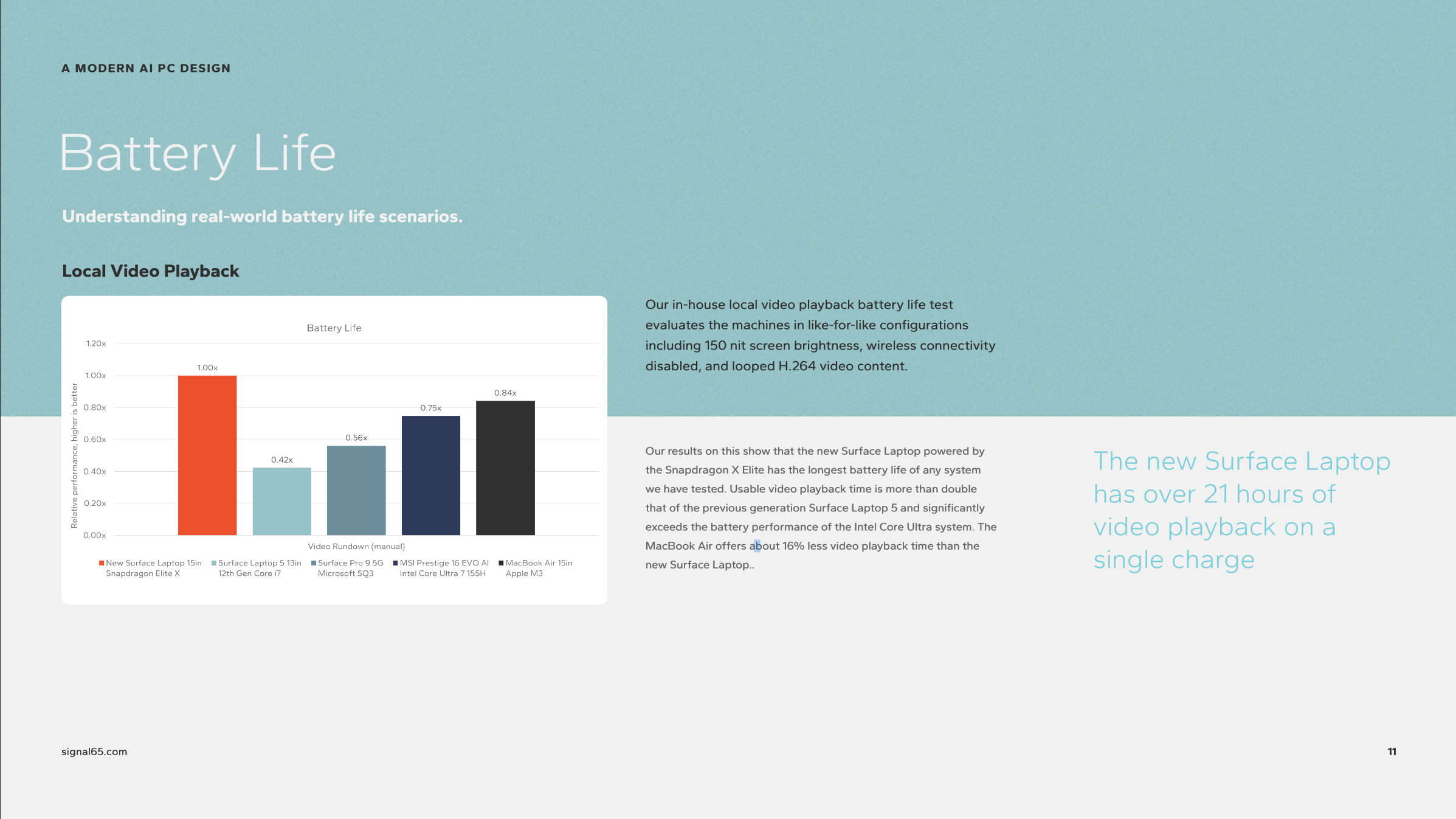Early Snapdragon X Elite benchmarks seemingly confirm the chip's incredible performance and battery life potential

Microsoft's all-new Surface Laptop sporting Qualcomm's Snapdragon X Elite SoC has been tested and reviewed by a third party, Signal65. The review was commissioned by Microsoft, and other reviewers haven't been able to chime in just yet, but the results seem to confirm what Qualcomm has been saying. The testing compared the X Elite-equipped Surface to four other devices in a plethora of benchmarks, including thermal testing, to see how Qualcomm's new silicon stacks up.
Ryan Shrout shows that Qualcomm's Snapdragon X Elite SoC delivers as advertised. The chip boasts outstanding AI performance and features incredibly long battery life in Microsoft's latest Surface laptop. CPU performance was also excellent, often outperforming Intel's Meteor Lake processors and, at times, outperforming Apple's M3 silicon. The chip also boasts good thermal behavior, featuring competitively low surface temperatures even under maximum load.
The new X Elite Surface laptop was compared with Microsoft's older Surface Laptop 5 sporting an Alder Lake Core i7-1255U, the Surface Pro 9 with SQ3 silicon, MSI's Prestige 16 AI EVO sporting Intel's latest Meteor Lake Core Ultra 7 155H, and Apple's latest MacBook Air 15 running on M3 silicon.



Beginning with the thermal test results, the Snapdragon X Elite-equipped Surface laptop fell behind its Alder Lake predecessor as well as Apple's M3-equipped MacBook Air, but was competitive with MSI's Meteor Lake laptop. In a multi-threaded run of Cinebench 2024, the X Elite-equipped Surface laptop had a hotspot temp of 50.3C and the MSI Prestige 16 EVO had a hotspot temp of 56.2C. Apple's M3 MacBook Air did the best, with a hotspot of 45.8C, and the previous generation Surface had a 47.1C hotspot.
Dropping to a lighter single-threaded Cinebench workload, the Snapdragon X Elite Surface showed much better results, with a hotspot temp of 37.4C. The MacBook Air again ranked first with a 35.1C hotspot, followed by the MSI at 41.3C and the Surface 5 brought up the rear at 44.1C.
Singnal65 conducted two battery life tests, one with local video playback and the other using the Procyon productivity test. The Snapdragon X Elite did excellent here, beating out all of the other laptops in both battery life tests, though it didn't test the MacBook in Procyon. In the local video playback test, the MacBook M3 Air came in second with 16% less battery life, the MSI was 25% behind the Snapdragon, the Surface Pro 9 SQ3 delivered 44% less battery life, and the older Surface 5 offered 58% worse battery life — less than half as long as the X Elite Surface.
The Procyon battery life tests were closer, with the Core Ultra 7 155H Meteor Lake chip only 10% behind, the Surface 9 Pro was 32% behind, and the Alder Lake Surface 5 came in 41% behind. Stats weren't provided for the MacBook Air, but Signal65 says it offers equivalent battery life to the Snapdragon X Elite in this test.
Signal65 ran a variety of compute benchmarks, including Cinebench, Geekbench, and AI workloads. The Snapdragon X Elite delivered the top results in both Cinebench and Geekbench for multi-threaded performance, though the Apple M3 outpaced it in the single-threaded tests by 15 and 17% respectively. The Intel Meteor Lake chip wasn't too far behind, with the Snapdragon X Elite leading by 5% to 18% in these benchmarks.
The Snapdragon X Elite completely dominated its competitors in AI workloads, thanks to its 45 teraops NPU. It's the first chip to sport 45 TOPS of performance for just the NPU (i.e. without help from the CPU and GPU). In the Procyon AI computer vision benchmark, the Snapdragon was basically twice as fast as Apple's competing M3 silicon, also double the performance of the Microsoft SQ3 chip, and over triple the performance of Intel's Core Ultra 7 155H processor. (The older Alder Lake chip couldn't run this particular test, as it lacks an NPU.)
Emulation performance was also tested, where the Snapdragon X Elite proved surprisingly potent. Emulation on the Snapdragon X Elite is achieved through Windows 11 on ARM's brand new translation layer, which Microsoft dubs Prism. It's supposed to boost emulation performance by 10 to 20% on Windows 11 24H2 compared to older hardware/OS revisions.
The new translation layer did not disappoint, with the X Elite easily besting the Microsoft SQ3 and Alder Lake chips, matching the Core Ultra 7 in PugetBench Lightroom Classic, but falling behind the Apple M3 and Meteor Lake chips in Blender 4.11. Note however that the Microsoft SQ3 and Apple M3 wouldn't run the Lightroom classic test.
Graphics performance also looks competitive. The X Elite was roughly twice as fast as the Alder Lake and SQ3 chips, though the integrated Arc Graphics in Meteor Lake were 22–35 percent faster in two of the 3DMark tests (but tied in the lighter Wild Life test). The Apple M3 was also faster in two of the tests, leading by 29–31 percent, but it couldn't run the new Steel Nomad test.
You can check the full review for additional productivity, web, and media processing performance results. In short, the X Elite does reasonably well in all of those, trading blows with the Apple M3 and Meteor Lake chips while easily outclassing the slower Microsoft SQ3. However, it's important to remember that this is a commissioned review, paid for by Microsoft. As such, it's hardly surprising that the text ends up being highly favorable of the new Surface laptop. We look forward to doing our own truly independent testing in the coming days.
Get Tom's Hardware's best news and in-depth reviews, straight to your inbox.

Aaron Klotz is a contributing writer for Tom’s Hardware, covering news related to computer hardware such as CPUs, and graphics cards.